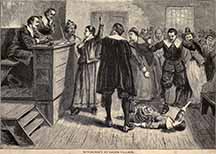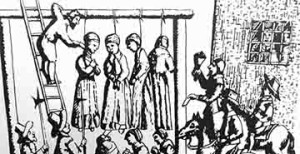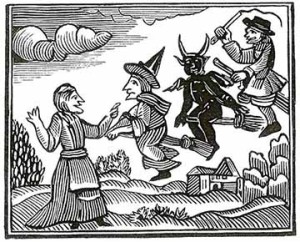Historical fiction author Karen Perkins takes a stab at the “why” of two historical witch hunts.
###
 Relevant History welcomes historical fiction author Karen Perkins, author of the Yorkshire Ghost Stories, the Pendle Witch Short Stories, and the Valkyrie Series of historical nautical fiction. All of her fiction has appeared at the top of bestseller lists on both sides of the Atlantic, including the top 21 in the UK Kindle Store in 2018. To learn more about Karen and her books, visit her web site, and follow her on Facebook, Twitter, Instagram, and Goodreads.
Relevant History welcomes historical fiction author Karen Perkins, author of the Yorkshire Ghost Stories, the Pendle Witch Short Stories, and the Valkyrie Series of historical nautical fiction. All of her fiction has appeared at the top of bestseller lists on both sides of the Atlantic, including the top 21 in the UK Kindle Store in 2018. To learn more about Karen and her books, visit her web site, and follow her on Facebook, Twitter, Instagram, and Goodreads.
*****
 The horror of the Salem Witch Trials in Massachusetts in 1692 is well known, especially as it involved children as accusers leading to trials and executions. But did you know that a similar scenario played out eighty years before in the north of England?
The horror of the Salem Witch Trials in Massachusetts in 1692 is well known, especially as it involved children as accusers leading to trials and executions. But did you know that a similar scenario played out eighty years before in the north of England?
The largest difference between the two witch hunt frenzies seems to be that the Salem trials are now believed to be caused by the ergot fungus; the girls who accused their neighbours were poisoned by their bread. But why were they believed so readily, and to the point where nineteen people were hanged, and another 150 accused, harangued, and lived in fear for their lives?
 The answer may well lie in Lancashire, England, wherein lies Pendle Forest. Within this area, in the shadow of the ominously looming Pendle Hill, lay a humble abode with the rather grand name of Malkin Towers. Although the witch trials sucked in many women from the surrounding countryside, this was the hub of the Pendle Witch Hunts, which led to trials at the ancient Lancaster and York Castles.
The answer may well lie in Lancashire, England, wherein lies Pendle Forest. Within this area, in the shadow of the ominously looming Pendle Hill, lay a humble abode with the rather grand name of Malkin Towers. Although the witch trials sucked in many women from the surrounding countryside, this was the hub of the Pendle Witch Hunts, which led to trials at the ancient Lancaster and York Castles.
 Growing up not far away in the Yorkshire Dales, I had long known of the “Pendle Witches.” I wanted to find out more and understand how and why the witch trials had happened at all, and was determined to write about them. I had already written one book set in Haworth, the home village of Charlotte, Emily and Anne Brontë (Parliament of Rooks), and as Haworth is literally over the hill from Pendle (Cathy and Heathcliff may well have been able to see Pendle Hill from Wuthering Heights), the Pendle witch trials became the inspiration for my second (and forthcoming) Ghosts of Haworth novel, A Question of Witchcraft.
Growing up not far away in the Yorkshire Dales, I had long known of the “Pendle Witches.” I wanted to find out more and understand how and why the witch trials had happened at all, and was determined to write about them. I had already written one book set in Haworth, the home village of Charlotte, Emily and Anne Brontë (Parliament of Rooks), and as Haworth is literally over the hill from Pendle (Cathy and Heathcliff may well have been able to see Pendle Hill from Wuthering Heights), the Pendle witch trials became the inspiration for my second (and forthcoming) Ghosts of Haworth novel, A Question of Witchcraft.
However, as I researched the lives and trials of the women caught up in the craze of witch hunting, they drowned out the voices of my Haworth characters, and I knew I had to write their stories first. Above all, I had to do them justice.
Parliament of Rooks and A Question of Witchcraft are both dual-timeline novels and combine historical fiction with the supernatural, but I wanted to keep my books about the Pendle Witches as true to the known facts as possible. I have therefore focused on the evidence given at their trials to recreate what happened to these women and children—how they were used, manipulated, and above all persecuted—in a series of short stories, in an attempt to understand what sparked this lust for hunting “witches.”
The short answer is religious intolerance.
The European Reformation
The Reformation in Europe led to a strong divide, and even hatred, between Protestants and Catholics for more than a century. Each country’s religion was enforced without mercy. If your religion did not concur with your current King or Queen’s, then you faced horrific torture and hanging or burning as a heretic.
The notion of witchcraft soon became synonymous with heresy with the publication of Malleus Maleficarum—a guide to recognizing, catching, and punishing witches written by two Inquisitors, Kramer and Sprenger—and the craze for witch hunting began in earnest. Overall in Europe, over 80,000 people were put to death for witchcraft between 1500 and 1660. Eighty percent of them were women.
 In England, King Henry VIII broke from the Catholic Church to set up the Church of England. Then the country swayed brutally back and forth between Protestantism and Catholicism with successive monarchs, plus a Puritan parliament during the English Civil War in the mid-1600s. No wonder people were keen to brave the dangers of a six-week ocean voyage aboard the Mayflower and similar ships for the freedom to practice their religion without persecution in Massachusetts Bay!
In England, King Henry VIII broke from the Catholic Church to set up the Church of England. Then the country swayed brutally back and forth between Protestantism and Catholicism with successive monarchs, plus a Puritan parliament during the English Civil War in the mid-1600s. No wonder people were keen to brave the dangers of a six-week ocean voyage aboard the Mayflower and similar ships for the freedom to practice their religion without persecution in Massachusetts Bay!
The cunning ways
But religion was only one reason why the Pendle women were accused. Just why were they singled out amongst others who managed to live safely? The only recourse to health the common man or woman had were the local “cunning ways,” and the cunning women also practiced as midwives. They saved many lives through medical knowledge of birthings passed down through generations and also made salves and potions from herbs and other natural substances to heal and cure.
In their role as midwives, they were authorized under the Catholic Church to perform the rite of baptism on a baby unlikely to survive long enough to be baptized in church. This was so that the child could be buried within the churchyard; unbaptized babies were considered full of sin and were not permitted to be buried in sanctified ground! Many stillborn babies were also “baptized” to allow a Christian burial and ease the pain of the parents at least a little.
The Protestant Church of England did not approve of women baptizing babies, even in dire situations, and going against the will of the Church was dangerous. This made these women vulnerable. If a baby or mother died during childbirth, it was easy to blame the midwife, especially if that woman was disliked, poor, and willing to sell a charm or a curse on the side. Even more so if she was crossed and the man or woman that did her wrong then fell foul to disease or loss.
So they must be witches, they must be tried as such, and they must be put to death.
If only humanity would learn from history…
Sources:
https://www.history.com/topics/colonial-america/salem-witch-trials
https://www.history.com › topics › folklore › history-of-witches
*****
 A big thanks to Karen Perkins! She’ll give away either a Kindle ebook or Audible audiobook of her historical fiction short story, Murder by Witchcraft, to three people who contribute a comment on my blog this week. I’ll choose the winner from among those who comment by Friday at 6 p.m. ET. Delivery is available worldwide.
A big thanks to Karen Perkins! She’ll give away either a Kindle ebook or Audible audiobook of her historical fiction short story, Murder by Witchcraft, to three people who contribute a comment on my blog this week. I’ll choose the winner from among those who comment by Friday at 6 p.m. ET. Delivery is available worldwide.
**********
Did you like what you read? Learn about downloads, discounts, and special offers from Relevant History authors and Suzanne Adair. Join Suzanne Adair’s Patreon, and subscribe to her free newsletter.
